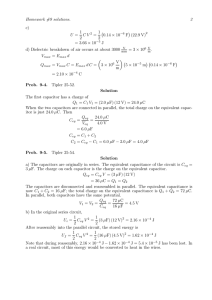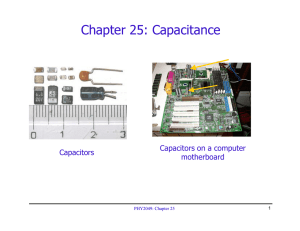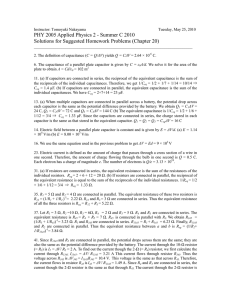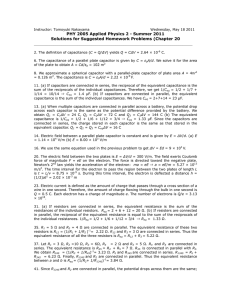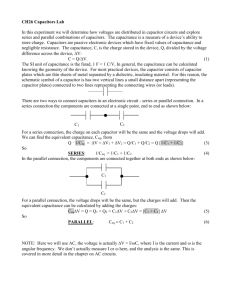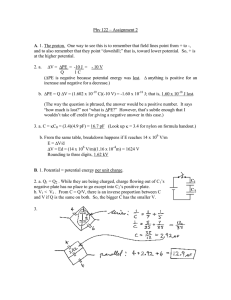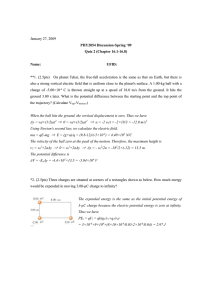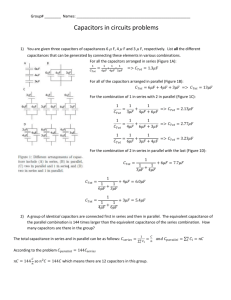Capacitors in Series and Parallel
advertisement
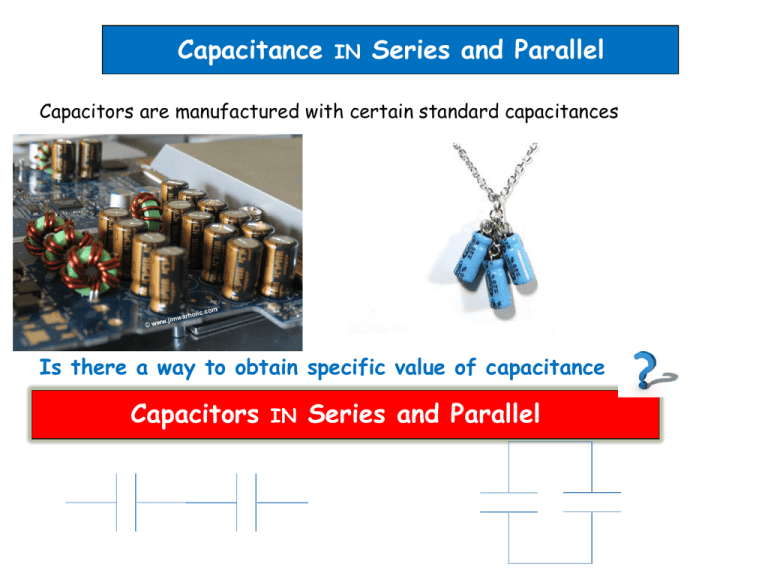
Capacitance IN Series and Parallel Capacitors are manufactured with certain standard capacitances Is there a way to obtain specific value of capacitance Capacitors IN Series and Parallel Capacitance IN Series a +Q + + + + -Q - - - - C1 Vac=V1 Vab=V c +Q + + + + C2 Vcb=V2 -Q - - - - V ac V1 C1 V cb V 2 b V ab Q Q C2 1 1 V V1 V 2 Q C1 C 2 V Q 1 C1 1 C2 The combination can be replaced by a equivalent capacitance Ceq C eq V Q 1 C eq Q V 1 1 C1 C2 1 1 C1 ++++ Ceq ---- +Q -Q C2 In general for any number of capacitors in Series 1 C eq 1 C1 1 C2 1 ...... C3 Note: Magnitude of charge on each capacitor is the same, however potential difference can be different V=V1+V2+V3+ … V Capacitance IN Parallel a ++++ ++++ Vab=V C1 Q1 ---- C2 Q2 ---- b The charges are Q1 C 1V Q 2 C 2V Q Q1 Q 2 ( C 1 C 2 )V Q V C1 C 2 C eq C eq C 1 C 2 Q Ceq V In general for any number of capacitors in parallel C eq C 1 C 2 C 3 ... ++++ Q=Q1+Q2 ---- Intuitive understanding Using the plate capacitor formula we derive the equivalent capacitance intuitively Parallel plate capacitor 𝐴𝜖0 𝐶= 𝑑 Two identical plate capacitors in series means effectively increasing the d +Q -Q d equipotential +Q -Q d +Q -Q 1 2𝑑 1 1 = = + 𝐶𝑒𝑞 𝐴𝜖0 𝐶 𝐶 d d Intuitive understanding Two identical plate capacitors in parallel means effectively increasing A in 𝐶 = +Q 𝐴𝜖0 𝑑 +Q -Q d equipotential d A A A A +Q -Q +Q -Q -Q d d 𝐶𝑒𝑞 = 2𝐴𝜖0 =𝐶+𝐶 𝑑 Clicker Question The three configurations shown below are constructed using identical capacitors. Which of these configurations has lowest total capacitance? C B A C C C C C Ctotal C 1/Ctotal 1/C 1/C 2/C Electricity & Magnetism Lecture 8, Slide 7 Ctotal C/2 212H: Capacitance and Dielectric Ctotal 2C Example C2 C1 V C3 (a)Determine the equivalent capacitance of the circuit shown if C1 = C2 = 2C3 = 12.5 F. (b) How much charge is stored on each capacitor when V = 45.0 V? Middle Branch: 1/Ceq = 1/C2 + 1/C3 1/Ceq = 1/12.5 F + 1/6.25 F Ceq = 4.16667 F Combine parallel: C = C1 + Ceq C = 12.5 F + 4.1666667 F = 16.6667 F Voltage over each parallel branch is same as the battery: C1: 45.0 V Q1=C1V= 12.5 F 45V= 562.5μC Ceq: 45.0 V Series: V=V1 + V2 = q/C2 + q/C3 = q/Ceq q = CeqV q = (4.166667 F)(45V)= 187.5μC C2: V = q/C = 187.5 μ C/12.5 F = 15 V C3: V = 187.5 μ C/6.25 F = 30 V Energy storage in Capacitors -Q +Q V Q C At an intermediate time (t<tcharged) V=Va-Vb q is the charge v is the potential difference Vb Work dW required to transfer an additional charge dq Va dW vdq qdq C The total work W required to increase capacitor charge from 0 to Q W W dW 1 Q qdq C Q 2 2C We define potential energy of an uncharged capacitor to be zero then W is equal to potential energy U 0 U 0 Q 2 2C 1 2 CV 2 1 2 QV Electric field energy We derived the various forms of electric potential energy stored in a capacitor U Q 2 2C 1 CV 2 2 1 2 QV If we think about charging a capacitor by moving charge from one plate to the other that requires work against the electric field We can think of the energy being stored in the electric field 𝑈 𝐶𝑉 2 we can introduce the energy density 𝑢 = = 𝐴𝑑 2𝐴𝑑 𝐴𝜖 Using the parallel plate capacitor expressions 𝑉 = 𝐸𝑑 and 𝐶 = 0 𝑑 Vacuum is not truly 𝐴𝜖0 𝐸 2 𝑑 2 1 2 = 𝜖0 𝐸 energy density 𝑢 = empty space but 2𝐴𝑑 2 2 can have energy 1 With 𝑈 = 𝐶𝑉 2 2


